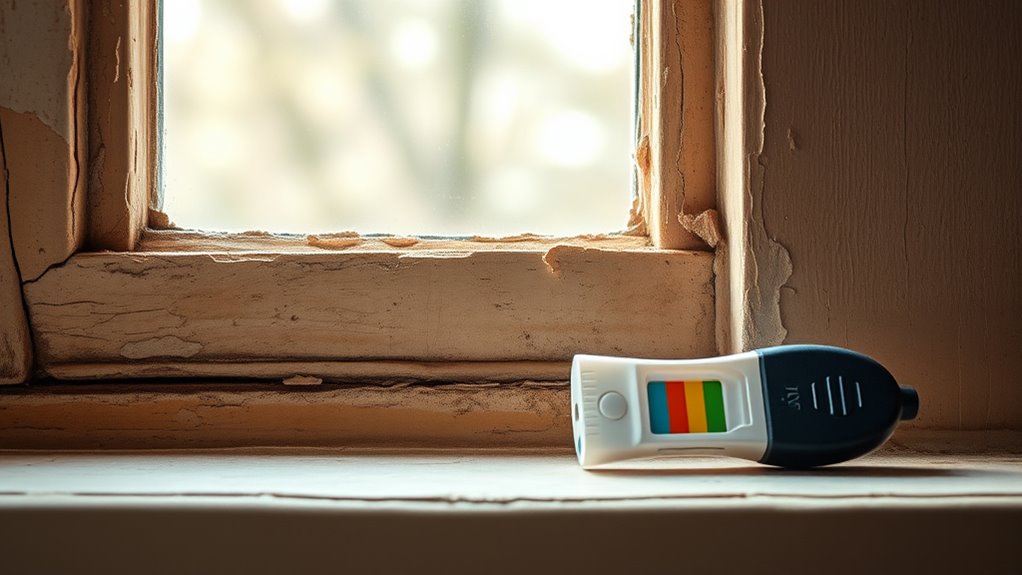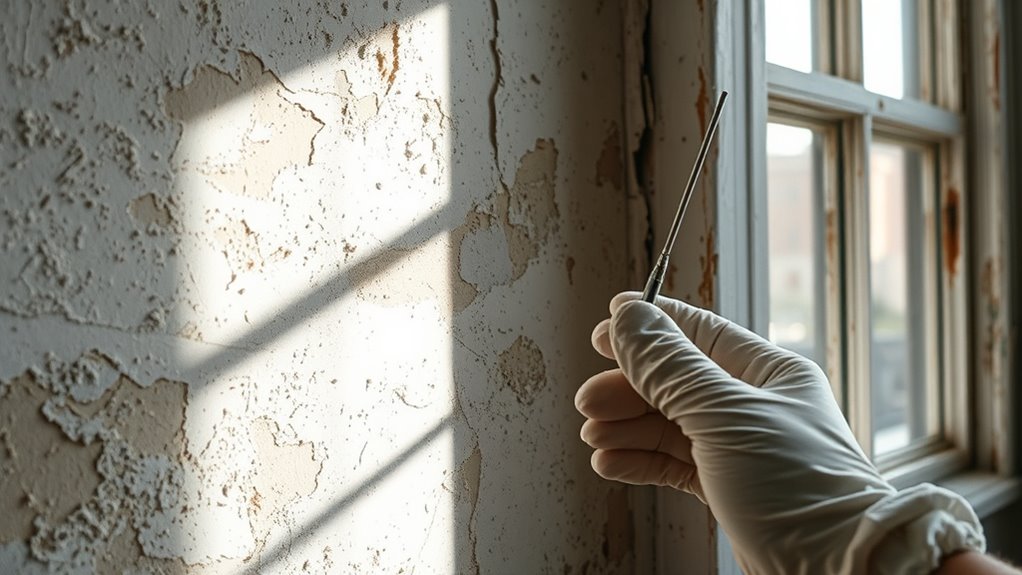If you suspect lead paint on your interior walls, start by testing with DIY kits or hire professionals for accurate results. If testing confirms lead, avoid disturbing the paint with sanding or scraping, as this release hazardous dust. Instead, consider encapsulation or hire certified experts for safe removal. Always use proper protective gear and cleaning methods. Keeping these precautions in mind can safeguard your family’s health and ensure safe home updates—there’s more to learn if you keep exploring.
Key Takeaways
- Homes built before 1978 likely contain lead-based paint; testing confirms its presence.
- Use DIY kits for initial screening, but professional testing ensures accurate results.
- Avoid sanding or scraping lead paint; consider encapsulation or hiring professionals for removal.
- Follow lead-safe work practices: wear PPE, wet surfaces, and clean thoroughly after disturbance.
- Hire licensed experts for extensive or deteriorating lead paint to ensure safe and effective abatement.

Have you ever wondered if the paint on your interior walls might contain lead? If your home was built before 1978, there’s a good chance that lead-based paint was used, which can pose serious health risks. Lead paint hazards are especially dangerous for children, pregnant women, and pets. As paint deteriorates over time, it chips, peels, or turns dust, increasing the likelihood of ingesting or inhaling lead particles. Recognizing these hazards is the first step toward protecting yourself and your family. You might consider testing your walls, which can be done with DIY kits or by hiring a professional. Testing confirms whether lead-based paint is present and helps you determine the necessary precautions.
When it comes to removal techniques, safety must be your top priority. Disturbing lead paint without proper precautions can release dangerous dust into your environment. If you find lead paint, you should avoid sanding, scraping, or heat stripping on your own, as these methods can create hazardous lead dust. Instead, consider encapsulation, which involves sealing the paint with specialized paints or coatings that prevent lead particles from becoming airborne. Encapsulation is a less invasive method suitable for intact paint surfaces. For more extensive damage or deteriorating paint, professional abatement services are recommended. Professionals use specialized equipment and techniques, like wet scraping or chemical stripping, which minimize dust and contamination. They also follow strict safety protocols, such as sealing off the work area, using HEPA-filtered vacuum systems, and wearing personal protective equipment.
If you’re determined to remove lead paint yourself, educate yourself on proper lead-safe work practices. Use disposable coveralls, gloves, and masks to prevent ingestion or inhalation of lead dust. Wet the paint surface before scraping or removing it to reduce dust creation. Always clean the area thoroughly afterward with a HEPA vacuum and wet wipes, and never burn or sand the paint, as these activities can release dangerous fumes and dust. Remember, any removal process should be approached with caution, and when in doubt, hiring licensed professionals is the safest option. They have the training and equipment to mitigate risks effectively. Additionally, understanding remote collaboration options can help you coordinate with experts easily if in-person work is not feasible. Ultimately, understanding the hazards of lead paint and employing the right removal techniques will help you maintain a healthier home environment. Protecting your loved ones from lead exposure is worth the effort, especially since lead poisoning can cause irreversible health issues. Staying informed and cautious ensures that your interior walls remain safe and free from lead-related hazards.
Frequently Asked Questions
How Can I Identify Lead Paint Without Testing?
You can identify lead paint without testing by performing a visual inspection, looking for signs like chipped, cracked, or peeling paint, especially if your home was built before 1978. Older homes are more likely to contain lead-based paint. Check for layers of paint with different colors underneath, or rough, chalky surfaces. If in doubt, it’s safest to consult a professional for proper testing and advice.
Are DIY Lead Paint Testing Kits Reliable?
DIY lead paint testing kits can be convenient, but their accuracy isn’t foolproof. They often face testing limitations, such as false negatives or positives, which could mislead you about the presence of lead. You should depend on professional testing for definitive results, as DIY accuracy varies and may not meet safety standards. Always prioritize expert evaluation to ensure your home’s safety and comply with health regulations.
What Are the Costs of Professional Lead Paint Testing?
You can expect professional lead paint testing costs to range from $200 to $600, depending on the size of your home and the type of testing needed. Investing in this service is vital for lead poisoning prevention and ensuring lead safe renovation practices. Hiring certified inspectors helps identify lead hazards accurately, protecting your family’s health and complying with safety regulations during renovation projects.
Can Lead Paint Be Safely Removed at Home?
You can attempt lead-safe removal at home, but it’s risky without proper knowledge. If you choose DIY precautions, wear protective gear, avoid sanding or scraping, and use lead-safe work practices to minimize dust. However, it’s best to hire certified professionals for lead-safe removal, ensuring no lead dust contaminates your home. Remember, improper removal can pose serious health risks, so prioritize safety and follow all recommended guidelines.
What Are the Health Risks of Lead Paint Exposure?
It’s a real blast from the past, but lead paint exposure can seriously harm your health. You risk lead poisoning, which can cause severe developmental issues, especially in children. Exposure may lead to learning disabilities, behavioral problems, and damage to the nervous system. Protect your loved ones by avoiding lead dust and paint hazards, and seek professional help if you suspect lead exposure. Your family’s childhood health depends on it.
Conclusion
Think of your home as a treasure chest, holding memories and safety inside. If lead paint lurks behind your walls, it’s like a hidden trap waiting to cause harm. Testing and safe removal are your keys to release peace of mind, turning your home back into a secure sanctuary. Don’t let unseen dangers turn your treasure into trouble—act now, and keep your loved ones safe, shining brightly within your walls.









